Key takeaways:
- Investor sentiment significantly influences market decisions, often deviating from fundamental analyses and causing rapid shifts in asset valuations.
- Methods for measuring sentiment include analyzing social media discussions, conducting surveys, and utilizing sentiment indices like the Fear and Greed Index.
- Tools such as behavioral finance metrics and sentiment-tracking apps provide valuable insights into investor psychology and market trends.
- Personal experiences underscore the importance of recognizing emotional responses in investing, highlighting that sentiment can drive market behavior beyond fundamental factors.
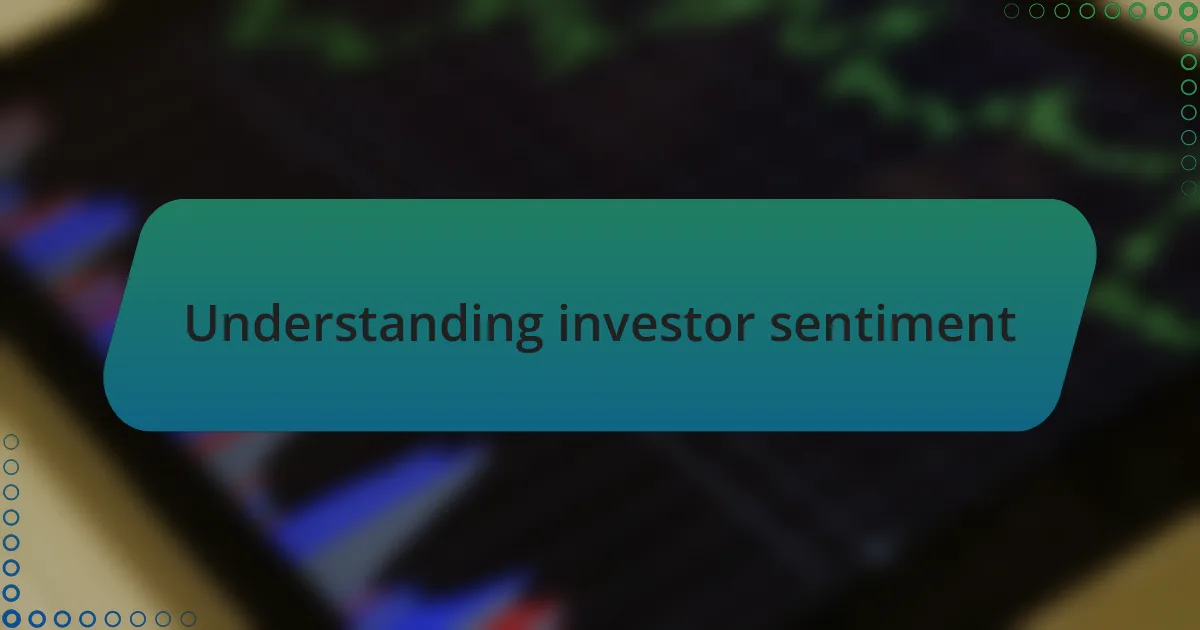
Understanding investor sentiment
Investor sentiment is a powerful force in the market, often swaying decisions in ways that fundamental analysis might not predict. I remember a time when a surge of optimism about a tech company led many investors, including myself, to overlook some red flags. Why do we let our emotions drive our decisions, especially when money is on the line?
Understanding investor sentiment requires us to delve into the collective psychology of the market. Sometimes, I find it fascinating how fear can bring a whole sector down, as seen during the early days of the pandemic when panic selling was rampant. How does a simple headline trigger such overwhelming responses, causing even seasoned investors to second-guess their strategies?
To accurately gauge this sentiment, I’ve learned to pay attention to market trends and social media buzz, which often act as barometers for mood shifts. Have you ever noticed how discussions on investment forums can ripple through stock prices? It’s important to recognize that these shifts in sentiment can happen quickly and often disproportionately affect asset valuations.
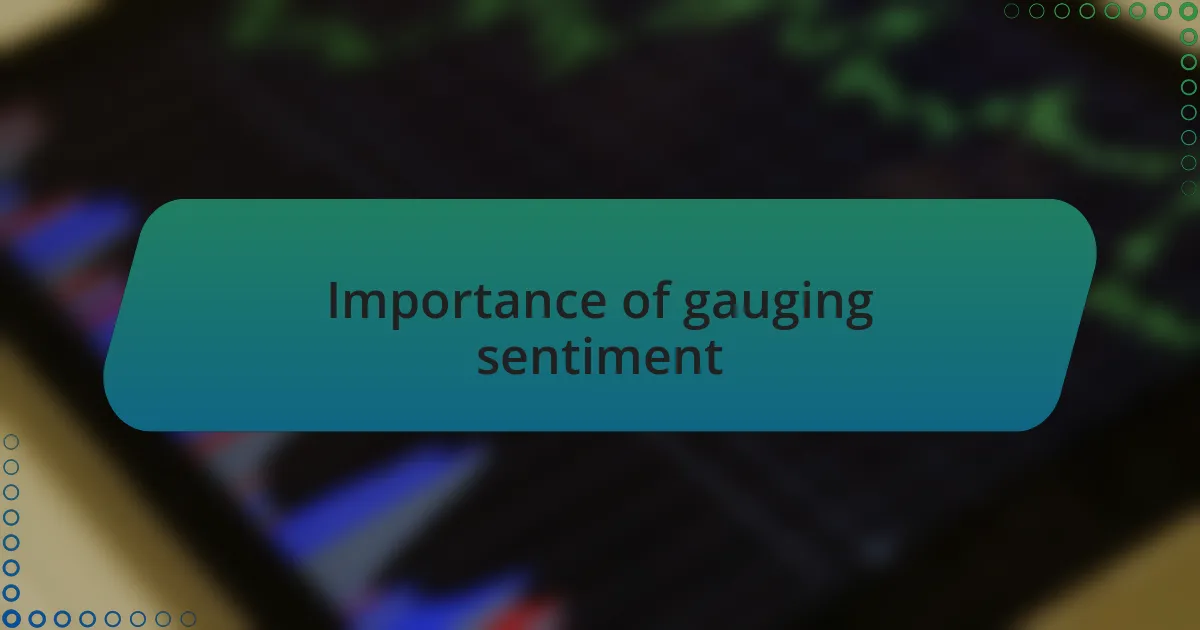
Importance of gauging sentiment
Gauging investor sentiment is crucial because it can provide early warning signals about market trends that traditional metrics may miss. I recall a time in my career when I underestimated the impact of negative news on the market, thinking my analysis was solid. However, as fear set in, I quickly learned that sentiment can create shifts that fundamental data simply can’t capture.
When I reflect on various market scenarios, particularly during volatile periods, the emotional responses of investors can dictate supply and demand in unexpected ways. For instance, watching a favorite stock tumble due to a rumor made me realize how quickly emotions can overshadow rational thought. Have you felt that rush of anxiety when a stock drops, only to find out later that it was based on unfounded speculation?
Understanding sentiment isn’t just about identifying what drives buying or selling; it’s about recognizing the psychological factors at play. I remember discussing with fellow investors how herd mentality can lead to bubbles and bursts, impacting everyone involved. Isn’t it intriguing how a simple change in mood can alter an entire market landscape? By paying close attention to sentiment, we can navigate our investment strategies with greater foresight and caution.
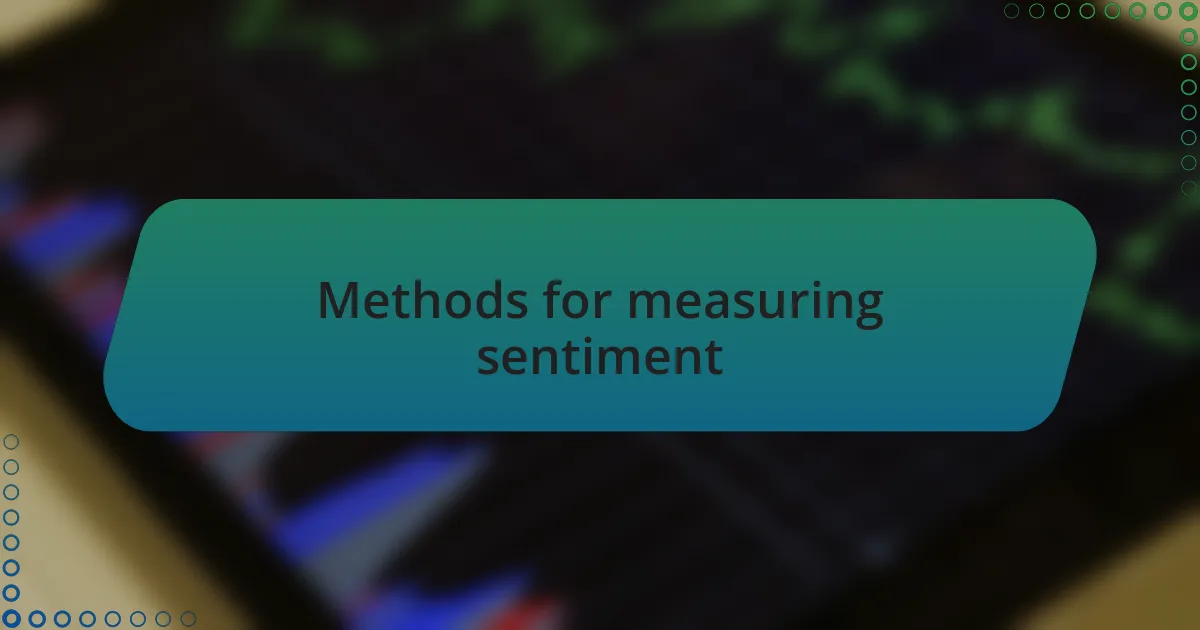
Methods for measuring sentiment
To effectively measure investor sentiment, one of the most common methods is analyzing social media and online discussions. I remember a time when I monitored Twitter around earnings season; the way people expressed excitement or fear through their tweets offered insights that traditional metrics often overlooked. Have you ever noticed how quickly sentiment shifts, sometimes even before the official news breaks?
Another valuable approach is sentiment analysis through surveys and polls. I’ve participated in several industry surveys, where the results highlighted prevailing investor moods, even when the overall market data appeared stable. It’s fascinating how a simple question can unveil a collective consciousness—do you think your peers are optimistic or cautious about market movements?
Sentiment indices are also a robust tool for gauging market mood. For example, I often reference the Fear and Greed Index, which encapsulates various indicators to signal whether investors are overly bullish or bearish. Reflecting on my own experiences, I’ve found that these indices can sometimes serve as a counterintuitive guide; when fear runs high, it can often present buying opportunities. Wouldn’t you agree that sometimes the best insights come from understanding what others are feeling rather than just what they’re saying?
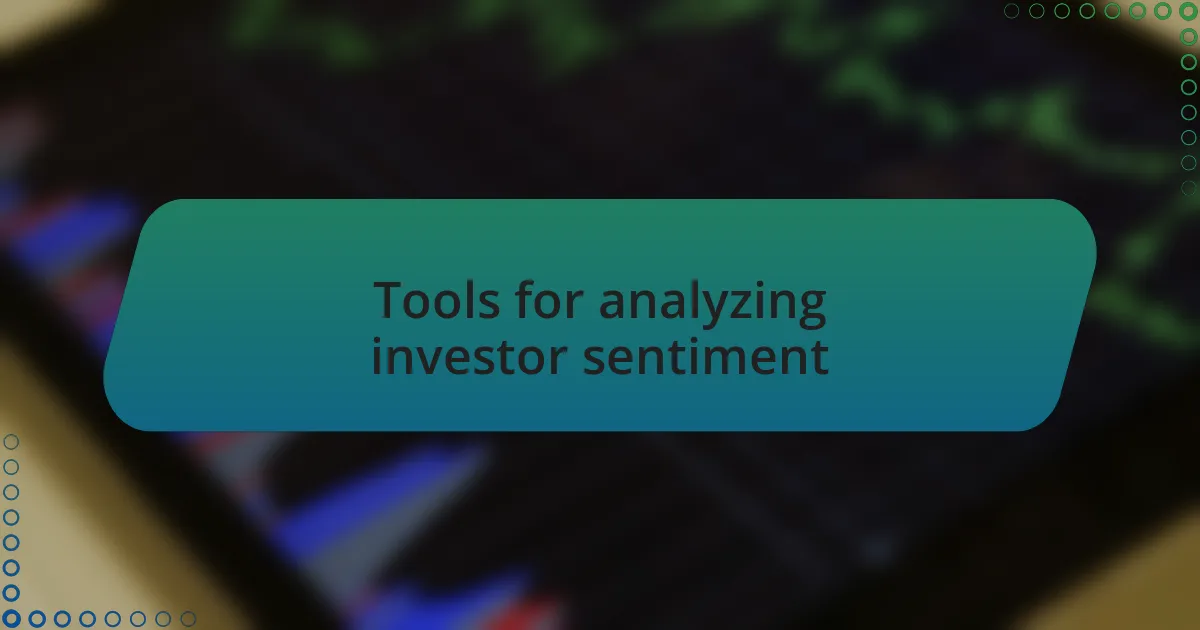
Tools for analyzing investor sentiment
When it comes to analyzing investor sentiment, quantitative tools like behavioral finance metrics can be incredibly insightful. I remember diving deep into metrics like the Put-Call Ratio during a particularly volatile market phase; it was amazing to see how changes in this ratio could predict shifts in market sentiment. Have you ever wondered how a single statistic could reflect so much about collective fear or confidence?
Another powerful tool in my experience is the use of sentiment-tracking apps that aggregate data from various sources. I’ve found platforms that visually represent sentiment trends across multiple sectors, allowing me to quickly gauge investor mood. It’s almost like having a pulse on the market at all times. When was the last time you checked how an app could simplify your understanding of market psychology?
Lastly, I cannot overlook the role of financial news outlets as sentiment gauges. I’ve often tuned into specific shows or reports that focus on expert opinions, which can heavily influence sentiment. During times of uncertainty, the tone of these discussions can either calm or stoke investor fears. Do you pay attention to how different commentators frame their narratives? Their emotional undertones can reveal a lot about the broader investor sentiment landscape.
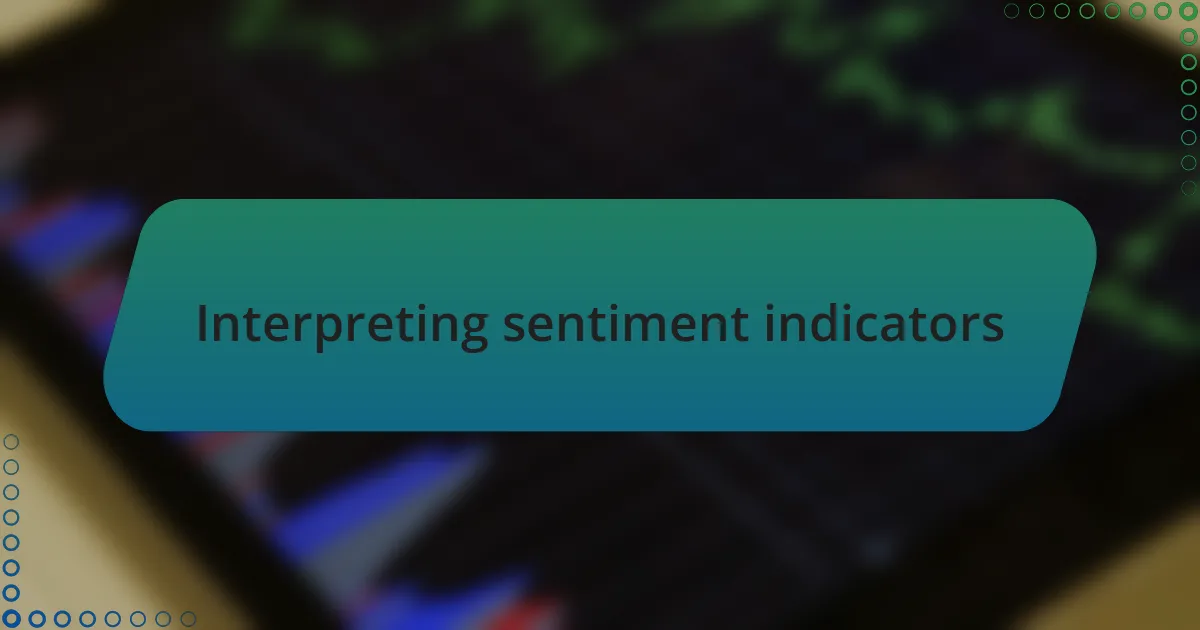
Interpreting sentiment indicators
Interpreting sentiment indicators requires a nuanced understanding of both the statistics and the psychological elements at play. For instance, when I analyze the Fear and Greed Index, I often find that extremes in either direction can signal not just emotional reactions but potential reversals in market trends. Isn’t it fascinating how fear can lead to hasty decisions, while greed might prompt risky investments?
One of my favorite sentiment indicators is the Consumer Sentiment Index, which reflects how optimistic or pessimistic consumers feel about the economy. I recall a time when I noticed a significant drop in this index just before a market dip; it served as a reminder that collective consumer emotions can often be a canary in the coal mine for broader market movements. Have you ever paid close attention to how consumer sentiment shapes your own investment choices?
Additionally, deciphering social media chatter has become a modern-day barometer for gauging sentiment. I often find myself scrolling through trending hashtags related to major financial events; the contrast between bullish and bearish discussions can provide real-time insights into how retail investors are feeling. It’s incredible to consider how a tweet or a viral post can sway opinions and subsequently influence market dynamics. What do you think about the power of digital voices in shaping investor sentiment today?
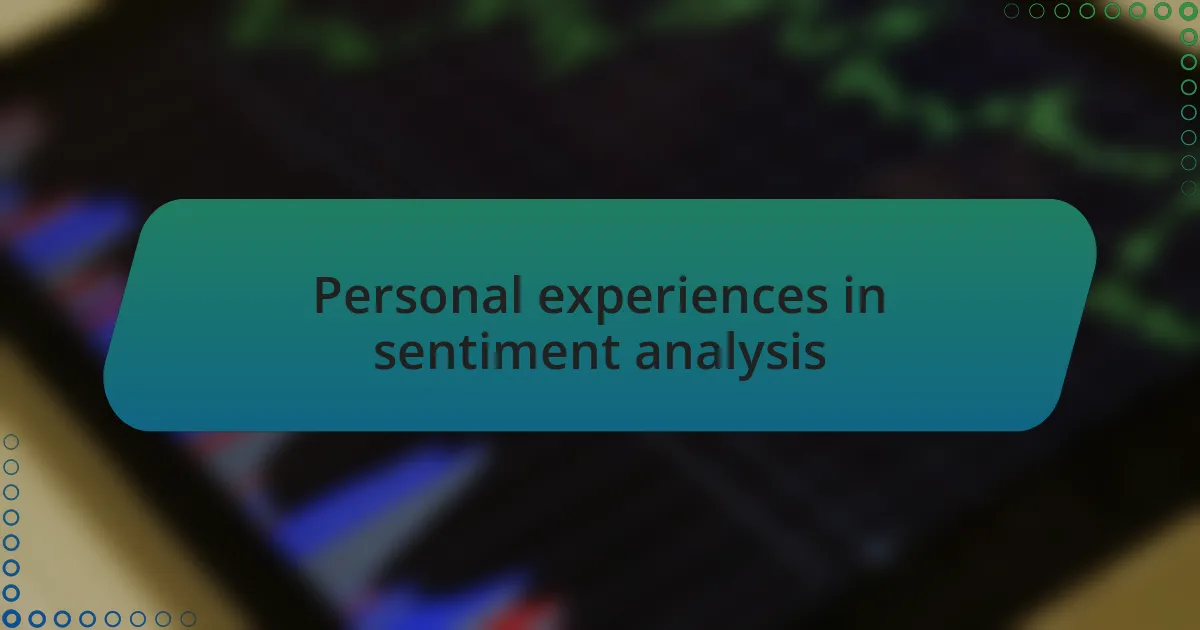
Personal experiences in sentiment analysis
During my journey in investment consulting, I’ve learned that analyzing investor sentiment is as much an art as it is a science. I recall a specific instance when I was closely monitoring various online forums just before a major earnings report. The heated debates and passionate posts from individual investors revealed a stark divide in expectations, which ultimately helped me adjust my portfolio accordingly. Have you ever experienced a time when the mood of the crowd shifted your perspective on an investment?
I also vividly remember attending a finance seminar where a keynote speaker discussed the impact of sentiment analysis on trading strategies. Their emphasis on understanding emotional triggers resonated with me deeply. The notion that our own fears and hopes can cloud decision-making is something I witness often; have you ever caught yourself second-guessing your choices because of market buzz?
One of the most telling moments in my career came from analyzing investor sentiment during a market correction. I noticed how panic set in for many, often driving price drops far more than fundamental issues warranted. This taught me the invaluable lesson that sentiment isn’t just a number; it’s an amalgamation of human emotions influencing market behavior. Have you reflected on how personal emotions can sometimes pull you away from a sound investment rationale?